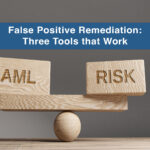The federal charges against former congressman Dennis Hastert have confused a lot of people—for while Hastert is alleged to have committed sexual improprieties with a minor from his distant past, the charges against him are related to his cash withdrawals of his own money that was legally obtained. In essence, Hastert withdrew his own money for personal purposes, and yet he is being charged with a crime related to those withdrawals.
For experts in AML risk mitigation, this will be no surprise. But it has created a lot of confusion among the general public, and it has created a backlash, too, about whether this type of prosecution for structured withdrawals is an example of government overreach.
In-depth stories in the New York Times and an NPR interview with former prosecutor Jeffrey Toobin explore this issue and explain how BSA regulations and related updates have placed emphasis on scrutinizing suspicious financial transactions to illuminate possible criminal activity, usually money laundering or terrorist financing.
Toobin notes that suspicious activity may in fact be legal, but that the scrutiny brought on by a currency transaction report will bear that out. Others, however, argue that the prosecution of Hastert on these charges—for what essentially was legal—though suspicious– withdrawal of his own money—is a waste of prosecutorial resources.
The New York Times, under the headline “When It’s a Crime to Withdraw Money from Your Bank,” further explains the ins and outs of the Hastert situation and the basis of the regulations in the BSA and the PATRIOT Act federal laws. Ironically, Hastert presided over congress during various deliberations about these issues.
Conor Friedersdorf in The Atlantic wrote about the Hastert indictment, and he noted with concern the irony of individuals facing criminal charges for wanting to access their personal assets legally and without scrutiny. The Hastert case is further complicated by the alleged past improprieties, which are long past the statute of limitations.
The Times notes, too, that the value of a $10,000 transaction—the ceiling at which reporting is engaged—has dropped drastically in real terms since the law was first passed in 1970. The story notes that $10,000 in 1970 today would be worth only $1,640. This $10,000 trigger requires about 15 million CTR reports today, according to the Times.
A final consideration regarding IRS involvement and the payment of large sums of cash is that the cash payments are taxable, even if they are for extortion. According to the Times, a 1952 Supreme Court case found that extortion profits are subject to taxes. Therefore, the IRS shares an interest in knowing whether large cash withdrawals will be paid out to someone who should pay taxes on those proceeds.
__________________________________
AML Partners specializes in providing AML/CTF software solutions to financial institutions. If you’re interested in learning how AML Partners can help your institution succeed with due diligence, behavioral monitoring, and sanctions screening, contact us today. Our SURETY Suite provides end-to-end AML compliance with peak efficiency and effectiveness.

